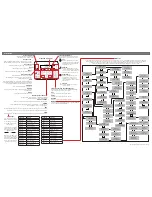
CK 2.2 Keypad
Programming Manual
And
(BKC-DIP) RS232 Guide
Updated 08/13/07
Page 69 of 87
Examples of RS232 Macros continued…
Example 2 - Turn off Junior’s Stereo from any Keypad
If Junior’s room is equipped with a local stereo unconnected to the central system, it is
still advantageous to program and install a keypad to control that local system. Not only
does Junior get the advantages of instant availability and control when he walks into the
room, his parents can turn off the system from any other keypad in the house. Thus, if
Junior falls asleep listening to music, Mom and Dad can turn it off without going to
Junior’s room.
To program; simply teach the kid’s room Keypad to control the system, set the keypad
ID# to a unique ID, then note the ID# and the button address (Device, Page, Button) and
program an RS232 Macro with BKc Suite (assigning an unused B&K code to trigger the
macro). Program all of the other keypads with a JROFF button, which contains the
trigger code.
In use, any keypad with a JROFF button sends the trigger code to the receiver. The
CT610/310/600 sends an RS232 message to Junior’s keypad, which turns off the local
stereo (since the message is specifically addressed to that keypad, no other keypad
jumps anywhere). Of course, no serial macro can turn Junior off when he complains that
someone has turned his system off.
Purpose of Keypad ID Numbers
Purpose of Keypad ID Numbers
The purpose of the Keypad Unit ID # is to enable specific keypads to be addressed via
RS232 communications. Thus you could have a keypad in the Kitchen send a special
B&K IR command to the CT Receiver, and then the CT would in turn send a specific
RS232 message to each room’s keypad instructing each one to turn off the local TV in
that room. Since each room’s keypad has a unique ID#, they will only respond to the
correct command.
ID #FF(255) is the Global Default
When you set a Keypad’s ID # you enable an RS232 message to be sent to this specific
keypad without affecting any other keypad. However, the keypad will still respond to any
message from the CT Receiver with the FF|255 prefix. FF|255 is the default and cannot
be deactivated. This is very useful, since the CT Receiver keypad status messages are
sent with the FF|255 prefix. Thus, you can set a keypad’s ID# to enable RS232 Macros
to be sent to a specific keypad, but the keypad will still respond to the normal keypad
status messages sent by the receiver whenever a zone input is changed by a remote
control, the front panel (if equipped) or another keypad.
















































